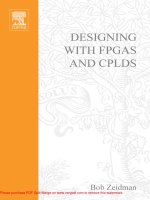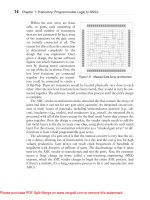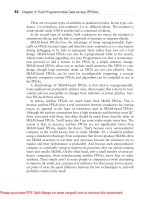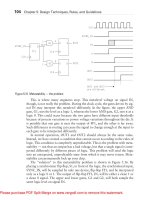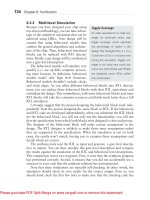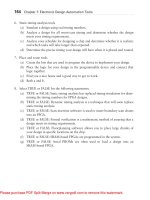- Trang chủ >>
- Đại cương >>
- Kinh tế vĩ mô
digital systems design with fpgas and cplds
Bạn đang xem bản rút gọn của tài liệu. Xem và tải ngay bản đầy đủ của tài liệu tại đây (9.39 MB, 763 trang )
Digital Systems Design with
FPGAs and CPLDs
This page intentionally left blank
Digital Systems Design with
FPGAs and CPLDs
Ian Grout
AMSTERDAM • BOSTON • HEIDELBERG • LONDON
NEW YORK • OXFORD • PARIS • SAN DIEGO
SAN FRANCISCO • SINGAPORE • SYDNEY • TOKYO
Newnes is an imprint of Elsevier
Newnes is an imprint of Elsevier
30 Corporate Drive, Suite 400, Burlington, MA 01803, USA
Linacre House, Jordan Hill, Oxford OX2 8DP, UK
Copyright Ó 2008, Elsevier Ltd. All rights reserved.
Material in Chapter 6 is reprinted, with permission, from IEEE Std 1076–2002 for VHDL Language Reference Manual, by IEEE.
The IEEE disclaims any responsibility or liability resulting from placement and use in the manner described.
MATLAB
Ò
and Simulink
Ò
are trademarks of The MathWorks, Inc. and are used with permission. The MathWorks does not
warrant the accuracy of the text or exercises in this book. This book’s use or discussion of MATLAB
Ò
and Simulink
Ò
software or related products does not constitute endorsement or sponsorship by The MathWorks of a particular pedagogical
approach or particular use of the MATLAB
Ò
and Simulink
Ò
software.
Figures based on or adapted from figures and text owned by Xilinx, Inc., courtesy of Xilinx, Inc. Copyright Ó Xilinx, Inc.,
1995–2005. All rights reserved.
Microsoft product screen shot(s) reprinted with permission from Microsoft Corporation.
No part of this publication may be reproduced, stored in a retrieval system, or transmitted in any form or by any means,
electronic, mechanical, photocopying, recording, or otherwise, without the prior written permission of the publisher.
Permissions may be sought directly from Elsevier’s Science & Technology Rights Department in Oxford, UK:
phone: (þ44) 1865 843830, fax: (þ44) 1865 853333, E-mail: You may also complete your request
online via the Elsevier homepage ( m), by selecting ‘‘Support & Contact’’ then ‘‘Copyright and Permission’’
and then ‘‘Obtaining Permissions.’’
Recognizing the importance of preserving what has been written, Elsevier prints its books on acid-free paper whenever possible.
Library of Congress Cataloging-in-Publication Data
Grout, Ian.
Digital systems design with FPGAs and CPLDs / Ian Grout.
p. cm.
Includes bibliographical references and index.
ISBN-13: 978-0-7506-8397-5 (alk. paper) 1. Digital electronics. 2. Digital circuits — Design
and construction. 3. Field programmable gate arrays. 4. Programmable logic devices. I. Title.
TK7868.D5.G76 2008
621.381—dc22
2007044907
British Library Cataloguing-in-Publication Data
A catalogue record for this book is available from the British Library.
For information on all Newnes publications
visit our Web site at www.books.elsevier.com
Printed in the United States of America
080910111213 10987654321
Working together to grow
libraries in developing countries
www.elsevier.com | www.bookaid.org | www.sabre.org
To my family, but especially to my parents and to Jane.
This page intentionally left blank
Table of Contents
Preface xvii
Abbreviations xxiii
Chapter 1: Introduction to Programmable Logic 1
1.1 Introduction to the Book 1
1.2 Electronic Circuits: Analogue and Digital 10
1.2.1 Introduction 10
1.2.2 Continuous Time versus Discrete Time 10
1.2.3 Analogue versus Digital 12
1.3 History of Digital Logic 14
1.4 Programmable Logic versus Discrete Logic 17
1.5 Programmable Logic versus Processors 21
1.6 Types of Programmable Logic 24
1.6.1 Simple Programmable Logic Device (SPLD) 24
1.6.2 Complex Programmable Logic Device (CPLD) 27
1.6.3 Field Programmable Gate Array (FPGA) 28
1.7 PLD Configuration Technologies 29
1.8 Programmable Logic Vendors 32
1.9 Programmable Logic Design Methods and Tools 33
1.9.1 Introduction 33
1.9.2 Typical PLD Design Flow 35
1.10 Technology Trends 36
References 38
Student Exercises 40
Chapter 2: Electronic Systems Design 43
2.1 Introduction 43
2.2 Sequential Product Development Process versus Concurrent
Engineering Process 52
www.newnespress.com
2.2.1 Introduction 52
2.2.2 Sequential Product Development Process 53
2.2.3 Concurrent Engineering Process 54
2.3 Flowcharts 56
2.4 Block Diagrams 58
2.5 Gajski-Kuhn Chart 61
2.6 Hardware-Software Co-Design 62
2.7 Formal Verification 65
2.8 Embedded Systems and Real-Time Operating Systems 66
2.9 Electronic System-Level Design 67
2.10 Creating a Design Specification 68
2.11 Unified Modeling Language 70
2.12 Reading a Component Data Sheet 72
2.13 Digital Input/Output 75
2.13.1 Introduction 75
2.13.2 Logic-Level Definitions 79
2.13.3 Noise Margin 81
2.13.4 Interfacing Logic Families 83
2.14 Parallel and Serial Interfacing 89
2.14.1 Introduction 89
2.14.2 Parallel I/O 95
2.14.3 Serial I/O 97
2.15 System Reset 102
2.16 System Clock 105
2.17 Power Supplies 107
2.18 Power Management 109
2.19 Printed Circuit Boards and Multichip Modules 110
2.20 System on a Chip and System in a Package 112
2.21 Mechatronic Systems 113
2.22 Intellectual Property 115
2.23 CE and FCC Markings 116
References 118
Student Exercises 121
Chapter 3: PCB Design 123
3.1 Introduction 123
3.2 What Is a PCB? 125
3.2.1 Definition 125
3.2.2 Structure of the PCB 127
3.2.3 Typical Components 139
3.3 Design, Manufacture, and Testing 144
3.3.1 PCB Design 144
viii Table of Contents
www.newnespress.com
3.3.2 PCB Manufacture 150
3.3.3 PCB Testing 151
3.4 Environmental Issues 152
3.4.1 Introduction 152
3.4.2 WEEE Directive 153
3.4.3 RoHS Directive 153
3.4.4 Lead-Free Solder 154
3.4.5 Electromagnetic Compatibility 154
3.5 Case Study PCB Designs 155
3.5.1 Introduction 155
3.5.2 System Overview 157
3.5.3 CPLD Development Board 158
3.5.4 LCD and Hex Keypad Board 160
3.5.5 PC Interface Board 163
3.5.6 Digital I/O Board 166
3.5.7 Analogue I/O Board 168
3.6 Technology Trends 171
References 173
Student Exercises 175
Chapter 4: Design Languages 177
4.1 Introduction 177
4.2 Software Programming Languages 177
4.2.1 Introduction 177
4.2.2 C 179
4.2.3 Cþþ 181
4.2.4 JAVA
TM
183
4.2.5 Visual Basic
TM
186
4.2.6 Scripting Languages 189
4.2.7 PHP 191
4.3 Hardware Description Languages 193
4.3.1 Introduction 193
4.3.2 VHDL 194
4.3.3 Verilog
Ò
-HDL 196
4.3.4 Verilog
Ò
-A 199
4.3.5 VHDL-AMS 202
4.3.6 Verilog
Ò
-AMS 205
4.4 SPICE 205
4.5 SystemC
Ò
208
4.6 SystemVerilog 209
4.7 Mathematical Modeling Tools 210
References 214
Student Exercises 216
www.newnespress.com
Table of Contents ix
Chapter 5: Introduction to Digital Logic Design 217
5.1 Introduction 217
5.2 Number Systems 222
5.2.1 Introduction 222
5.2.2 Decimal–Unsigned Binary Conversion 224
5.2.3 Signed Binary Numbers 226
5.2.4 Gray Code 231
5.2.5 Binary Coded Decimal 232
5.2.6 Octal-Binary Conversion 233
5.2.7 Hexadecimal-Binary Conversion 235
5.3 Binary Data Manipulation 240
5.3.1 Introduction 240
5.3.2 Logical Operations 241
5.3.3 Boolean Algebra 242
5.3.4 Combinational Logic Gates 246
5.3.5 Truth Tables 248
5.4 Combinational Logic Design 256
5.4.1 Introduction 256
5.4.2 NAND and NOR logic 269
5.4.3 Karnaugh Maps 271
5.4.4 Don’t Care Conditions 277
5.5 Sequential Logic Design 277
5.5.1 Introduction 277
5.5.2 Level Sensitive Latches and Edge-Triggered
Flip-Flops 282
5.5.3 The D Latch and D-Type Flip-Flop 283
5.5.4 Counter Design 288
5.5.5 State Machine Design 305
5.5.6 Moore versus Mealy State Machines 316
5.5.7 Shift Registers 317
5.5.8 Digital Scan Path 319
5.6 Memory 322
5.6.1 Introduction 322
5.6.2 Random Access Memory 324
5.6.3 Read-Only Memory 325
References 327
Student Exercises 328
Chapter 6: Introduction to Digital Logic Design with VHDL 333
6.1 Introduction 333
6.2 Designing with HDLs 334
x Table of Contents
www.newnespress.com
6.3 Design Entry Methods 338
6.3.1 Introduction 338
6.3.2 Schematic Capture 338
6.3.3 HDL Design Entry 339
6.4 Logic Synthesis 341
6.5 Entities, Architectures, Packages, and Configurations 344
6.5.1 Introduction 344
6.5.2 AND Gate Example 346
6.5.3 Commenting the Code 353
6.6 A First Design 355
6.6.1 Introduction 355
6.6.2 Dataflow Description Example 356
6.6.3 Behavioral Description Example 357
6.6.4 Structural Description Example 359
6.7 Signals versus Variables 366
6.7.1 Introduction 366
6.7.2 Example: Architecture with Internal Signals 368
6.7.3 Example: Architecture with Internal Variables 372
6.8 Generics 374
6.9 Reserved Words 380
6.10 Data Types 380
6.11 Concurrent versus Sequential Statements 383
6.12 Loops and Program Control 383
6.13 Coding Styles for VHDL 385
6.14 Combinational Logic Design 387
6.14.1 Introduction 387
6.14.2 Complex Logic Gates 388
6.14.3 One-Bit Half-Adder 388
6.14.4 Four-to-One Multiplexer 389
6.14.5 Thermometer-to-Binary Encoder 397
6.14.6 Seven-Segment Display Driver 398
6.14.7 Tristate Buffer 409
6.15 Sequential Logic Design 414
6.15.1 Introduction 414
6.15.2 Latches and Flip-Flops 416
6.15.3 Counter Design 422
6.15.4 State Machine Design 426
6.16 Memories 440
6.16.1 Introduction 440
6.16.2 Random Access Memory 441
6.16.3 Read-Only Memory 444
6.17 Unsigned versus Signed Arithmetic 447
6.17.1 Introduction 447
Table of Contents xi
www.newnespress.com
6.17.2 Adder Example 448
6.17.3 Multiplier Example 449
6.18 Testing the Design: The VHDL Test Bench 453
6.19 File I/O for Test Bench Development 459
References 471
Student Exercises 472
Chapter 7: Introduction to Digital Signal Processing 475
7.1 Introduction 475
7.2 Z-Transform 496
7.3 Digital Control 509
7.4 Digital Filtering 524
7.4.1 Introduction 524
7.4.2 Infinite Impulse Response Filters 532
7.4.3 Finite Impulse Response Filters 534
References 535
Student Exercises 536
Chapter 8: Interfacing Digital Logic to the Real World: A/D Conversion,
D/A Conversion, and Power Electronics 537
8.1 Introduction 537
8.2 Digital-to-Analogue Conversion 543
8.2.1 Introduction 543
8.2.2 DAC Characteristics 548
8.2.3 Types of DAC 555
8.2.4 DAC Control Example 559
8.3 Analogue-to-Digital Conversion 565
8.3.1 Introduction 565
8.3.2 ADC Characteristics 568
8.3.3 Types of ADC 572
8.3.4 Aliasing . 577
8.4 Power Electronics 580
8.4.1 Introduction 580
8.4.2 Diodes 581
8.4.3 Power Transistors 585
8.4.4 Thyristors 593
8.4.5 Gate Turn-Off Thyristors 603
8.4.6 Asymmetric Thyristors 604
8.4.7 Triacs 604
8.5 Heat Dissipation and Heatsinks 606
8.6 Operational Amplifier Circuits 610
xii Table of Contents
www.newnespress.com
References 612
Student Exercises 613
Chapter 9: Testing the Electronic System 615
9.1 Introduction 615
9.2 Integrated Circuit Testing 621
9.2.1 Introduction 621
9.2.2 Digital IC Testing 624
9.2.3 Analogue IC Testing 629
9.2.4 Mixed-Signal IC Testing 633
9.3 Printed Circuit Board Testing 633
9.4 Boundary Scan Testing 636
9.5 Software Testing 642
References 645
Student Exercises 646
Chapter 10: System-Level Design 647
10.1 Introduction 647
10.2 Electronic System-Level Design 654
10.3 Case Study 1: DC Motor Control 661
10.3.1 Introduction 661
10.3.2 Motor Control System Overview 662
10.3.3 MATLAB
Ò
/Simulink
Ò
Model Creation
and Simulation 665
10.3.4 Translating the Design to VHDL 666
10.3.5 Concluding Remarks 674
10.4 Case Study 2: Digital Filter Design 686
10.4.1 Introduction 686
10.4.2 Filter Overview 688
10.4.3 MATLAB
Ò
/Simulink
Ò
Model Creation
and Simulation 690
10.4.4 Translating the Design to VHDL 692
10.4.5 Concluding Remarks 698
10.5 Automating the Translation 702
10.6 Future Directions 703
References 704
Student Exercises 705
Additional References 707
Index 717
Table of Contents xiii
www.newnespress.com
This page intentionally left blank
system
• noun 1 A set of things working together as parts of a mechanism or an
interconnecting network.
Oxford Dictionary of English
This page intentionally left blank
Preface
In days gone by, life for the electronic circuit designer seems to have been easier.
Designs were smaller, ran at a slower speed, and could easily fit onto a single small
printed circuit board. An individual designer could work on a problem and designs
could be specified and developed using paper and pen only. The circuit schematic
diagrams that were required could be rapidly drawn on the back of an envelope.
Struck by the success of the early circuit designs, customers started to ask for smaller,
faster, and more complex circuits—and at a lower cost. The designers started to work
on solving such problems, which has led to the rapidly expanding electronics industry
that we have today. Driven by the demand from the customer, new materials and
fabrication processes have been developed, new circuit design methodologies and
design architectures have taken over many of the early traditional design approaches,
and new markets for the circuits have evolved.
So how is the design problem tackled today? This is not an easy question to answer, and
there is more than one way to develop an electronic circuit solution to any given
problem. However, the design process is no longer the activity of a single individual.
Rather, a team of engineers is involved in the key engineering activities of design,
fabrication (manufacture), and test. All activities now involve the extensive use of
computing resources, requiring the efficient use of software tools to aid design
(electronic design automation, EDA and computer aided design, CAD), fabrication
(Computer Aided Manufacture, CAM), and test (Computer Aided Test, CAT). The
circuit is no longer a unique and isolated entity. Rather, it is part of a larger system.
Increasingly, much of the design work is undertaken at the system level at a suitably
high level of design abstraction required to reduce design time and increase the designer
efficiency. However, when it comes to the design detail, the correctly specified system
must also work at the basic electric voltage and current level. How to go from an
www.newnespress.com
effective system-level specification to an efficient and working circuit implementation
requires the skills of good designers who are aided by good design tools.
For the electronic circuit d esigner at an early stage in the design process, w hether to
implement the required circuit functionality using analogue circuit techniques or digital
circuit techniques must be decided. However, sometimes the choice will have already been
made, and increasingly a digital solution is the preferred choice. The wide use of digital
signal processing (DSP) techniques facilitates complex operations that can provide superior
performance t o an analogue circuit equivalent; indeed some cannot be performed in
analogue. Traditionally, DSP f unctions have been implemented using software programs
written to operate on a target processor. The microprocessor (mP), microcontroller (mC),
and digital signal processor provide the necessary digital circuits, in integrated circuit (IC)
form, to implement the required functions. In fact, these processors are to be found in many
everyday embedded electronics that we take for granted. Th is book could not have been
written without the aid of a n electronic system incorporating a microprocessor running a
software o perating system that in turn ru ns the word processor software.
Increasingly, the functions that have been traditionally implemented in software
running on a processor-based digital system in the DSP world and many control
applications are being evaluated in terms of performance that can be achieved in
software. In many cases, the software solution will be slower than is desired, and the
basic nature of the software programmed system means that this speed limitation
cannot be overcome. The way to overcome the speed limitation is to perform the
required operations in hardware designed for a particular application. However,
custom hardware solutions will be expensive to acquire.
If there were a way to obtain the power of programmability with the power of
hardware speed, then this would be provide a significant way forward.
Fortunately, programmable logic provides the power of programmability with the
power of hardware speed by providing an IC with built-in digital electronic circuitry
that is configured by the user for a particular application. Many devices can be
reconfigured for different applications. Today, two main types of programmable logic
ICs are commonly used: the field programmable gate array (FPGA) and complex
programmable logic device (CPLD).
Therefore, it is possible to implement a complex digital system that can be developed
and the functionality changed or enhanced using either a processor running a
software program or programmable logic with a specific hardware configuration.
xviii Preface
www.newnespress.com
For an end-user, the functionality of both types of system will be the same—the
design details are irrelevant to the end-user as long as the functionality of the unit
is correct. In this book, to provide consistency and to differentiate between the
processor and programmable logic, the following terminology will be used:
• A processor (microprocessor, mP; microcontroller, mC; or digital signal
processor, DSP) will be programmed for a particular application using a
software programming language (SPL).
• Programmable logic (field programmable gate array, FPGA; simple
programmable logic device, SPLD; or complex programmable logic device,
CPLD) will be configured using a hardware description language (HDL).
The aim of this book is to provide a reference source with worked examples in
the area of electronic circuit design using programmable logic. In particular, field
programmable gate arrays and complex programmable logic devices will be presented
and examples of such devices provided.
The choice whether to use a software-programmed processor or hardware-configured
programmable logic device is not a simple one, and many decisions figure into evaluating
the pros and cons of a particular implementation prior to making a final decision. This
book will provide an insight into the design capabilities and aspects relating to the design
decisions for programmable logic so that an informed decision can be made.
The book is structured as follows:
Chapter 1 will introduce the types of programmable logic device that are available
today, their differing architectures, and their use within electronic system design.
Additionally, the terminology used in this area will be presented with the aim of
demystifying the jargon that has evolved.
Chapter 2 will provide a background into the area of electronic systems design, the
types of solutions that may be developed, and the decisions that will need to be
made in order to identify the right technology choice for the design implementation.
Typical design flows will be introduced and discussed for the different technologies.
Chapter 3 will introduce the design of printed circuit boards (PCBs). These provide the
mechanical and electrical base onto which the electronic components will be mounted. The
correct design of the PCB is essential to ensure that the electronic circuit can be realized
(implemented) to operate to the correct specification (power supply voltage, thermal [heat]
dissipation, digital clock frequency, analogue and digital circuit elements, etc.) and to
Preface xix
www.newnespress.com
ensure that the different electronic circuit components interact with each other correctly
and do not provide unwanted effects. A correctly designed PCB will allow the circuit to
perform as intended. A badly designed PCB will prevent the circuit from working
altogether.
Chapter 4 will discuss the different programming languages that are used to develop
digital designs for implementation in either a processor (software-programmed
microprocessor, microcontroller, or digital signal processor) or in programmable
logic (hardware-configured FPGA or CPLD). The main languages used will be
introduced and examples provided. For programmable logic, the main hardware
description languages used are Verilog
Ò
-HDL and VHDL (VHSIC Hardware
Description Language). These are IEEE (Institute of Electrical and Electronics
Engineers) standards, universally used in both education and industry.
Chapter 5 will introduce digital logic design principles. A basic understanding of the
principles of digital circuit design, such as Boolean Logic, Karnaugh maps, and
counter/state machine design will be expected. However, a review of these principles
will be provided for designs in schematic diagram form and presented such that the
design functionality may be mapped over a VHDL description in Chapter 6.
Chapter 6 will introduce VHDL as one of the IEEE standard hardware description
languages available to describe digital circuit and system designs in an ASCII
text-based format. This description can be simulated and synthesized. (Simulation
will validate the design operation, and synthesis will translate the text-based
description into a circuit design in terms of logic gates and the interconnections
between the basic logic gates. The gates and gate connections are commonly referred to
as the netlist.) The design examples provided in schematic diagram form in Chapter 5
will be revisited and modeled in VHDL.
Chapter 7 will introduce the development of digital signal processing algorithms in
VHDL and the synthesis of the VHDL descriptions to target programmable logic
(both FPGA and CPLD). Such algorithms include digital filters (low-pass, high-pass,
and band-pass), digital PID (proportional plus integral plus derivative) control
algorithms, and the FFT (fast Fourier transform, an efficient implementation of the
discrete Fourier transform, DFT).
Chapter 8 will discuss the interfacing of programmable logic to what is commonly
referred to as the real world. This is the analogue world that we live in, and such
interfacing requires both the acquisition (capture) and the generation of analogue
xx Preface
www.newnespress.com
signals. To enable this, the digital programmable logic device will require an interface to
the analogue world. For analogue signals to be captured and analyzed in digital, an
analogue-to-digital converter (ADC) will be required. For analogue signals to be
generated from the digital, a digital-to-analogue converter (DAC) will be required.
In this book, the convention used for the word analogue will use the -ue at the end of
the word, unless a particular name already in use is referred to spelled as analog.
Chapter 9 will introduce the testing of the electronic system. In this, failure mechanisms
in hardware and software will be introduced, and the need for efficient and
cost-effective test programs from the prototyping phase of the design through
high-volume manufacture and in-system testing.
Chapter 10 will introduce the increasing need to develop programmable logic–based
designs at a high level of abstraction using behavioral descriptions of the system
functionality, and the increasing requirements to enable the synthesis of these
high-level designs into logic. With reference to a design flow taking a digital design
developed in MATLAB
Ò
or Simulink
Ò
through a VHDL code equivalent for
implementation in FPGA or CPLD technology, the synthesis of digital control system
algorithms modeled and simulated in Simulink
Ò
will be translated into VHDL for
implementation in programmable logic.
Throughout the book, the HDL examples provided and evaluated can be implemented
within programmable logic–based circuits that may be designed by the user in addition
to the PCB design examples that are provided. These examples have been developed to
form the basis of laboratory experiments that can be used to accompany the text.
With the broad range of subject material and examples, a feature of the book is its
potential for use in a range of learning and teaching scenarios. For example:
1. As an introduction to design of electronic circuits and systems using
programmable logic. This would allow for the design approaches,
programmable logic architectures, simulation, synthesis, and the final
configuration of an FPGA or CPLD to be undertaken. It would also allow
for investigation into the most appropriate HDL coding styles and device
implementation constraints to be undertaken.
2. As an introduction to hardware description languages, in particular VHDL,
allowing for case study designs to be developed and implemented within
programmable logic. This would allow for VHDL code developers to see the
Preface xxi
www.newnespress.com
code working on real devices and to enable additional testing of the electronic
circuit with such equipment as oscilloscopes and spectrum analyzers.
3. As an introduction to the design of printed circuit boards, in particular
mixed-signal designs (mixed analogue and digital). This would allow issues
relating to the design of the printed circuit board to be investigated and
designs developed, fabricated, and tested.
4. As an introduction to digital signal processing algorithm development. This
would allow the basics of DSP algorithms and their implementation in
hardware on FPGAs and CPLDs to be investigated through the medium of
VHDL code development, simulation, and synthesis.
The VHDL examples can be downloaded and run on the hardware prototyping
arrangement that can be built by the reader using the designs provided in the book.
This hardware arrangement is centered on a Xilinx
Ò
Coolrunner
TM
-II CPLD on
which to prototype the digital logic ideas, along with a set of input/output (I/O)
boards. The full set of boards is shown in the figure below.
This arrangement consists of five main system boards and an optional seven-
segment display board. The appendices and design schematics are available at the
author’s Web site for this book (refer to />9780750683975 and follow the hyperlink to the author’s site).
www.newnespress.com
xxii Preface
Abbreviations
A
AC alternating current
ADC analogue-to-digital converter
ALU arithmetic and logic unit
AM amplitude modulation
AMD advanced micro devices
AMS analogue and mixed-signal
AND logical AND operation on two or more digital signals
ANSI American National Standards Institute
AOI automatic optical inspection
ASCII American Standard Code for Information Interchange
ASIC application-specific integrated circuit
ASP analogue signal processor
ASSP application-specific standard product
ATA AT attachment
ATE AT equipment
ATPG AT program generation
AWG arbitrary waveform generator
American wire gauge
AXI automatic X-ray inspection
B
BASIC Beginner’s All-purpose Symbolic Instruction Code
BCD binary coded decimal
BGA ball grid array
BiCMOS bipolar and CMOS
BIST built-in self-test
www.newnespress.com
bit binary digit
BJT bipolar junction transistor
BNC bayonet Neill-Concelman connector
BPF band-pass filter
BSDL boundary scan description language
BS(I) British Standards (Institution)
BST boundary scan test
C
CAD computer-aided design
CAE computer-aided engineering
CAM computer-aided manufacture
CAT computer-aided test
CBGA ceramic BGA
CD compact disk
CE chip enable
CERDIP ceramic DIP
CERQUAD ceramic quadruple side
CIC cascaded integrator comb
CISC complex instruction set computer
CLB configurable logic block
CLCC ceramic leadless chip carrier
ceramic leaded chip carrier
CMOS complementary metal oxide semiconductor
COTS commercial off-the-shelf
CPGA ceramic PGA
CPLD complex PLD
CPU central processing unit
CQFP ceramic quad flat pack
CS chip select
CSOIC ceramic SOIC
CSP chip scale packaging
CSSP customer specific standard product
CTFT continuous-time Fourier transform
CTS clear to send
CUT circuit under test
xxiv Abbreviations
www.newnespress.com


